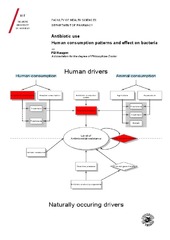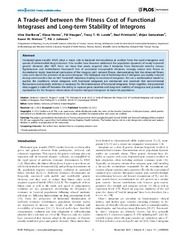| dc.contributor.advisor | Primicerio, Raul | |
| dc.contributor.author | Haugen, Pål | |
| dc.date.accessioned | 2015-02-26T07:06:17Z | |
| dc.date.available | 2015-02-26T07:06:17Z | |
| dc.date.issued | 2015-03-17 | |
| dc.description.abstract | Prescriptions of antibiotics in Norway, and the effect of antibiotics on bacteria were investigated. The aim was to describe the consumption of antibiotics through prescriptions to patients and address how antibiotics can favour bacterial resistance. Several methods were applied, multivariate statistics, quantile regression and mathematical modelling of experimental conditions aided in the investigations. Variation in prescription profiles was found for patient gender and age groups, as well as for prescriber age groups and gender. Prescriber age interacts with patient demographic variables and influence antibiotic prescription profiles. This was also found for prescriber gender within sub groups of patients. Further the total amount of antibiotics prescribed in Norwegian municipalities varies up to ten fold and is dependent on municipality size and a south north gradient. Finally it was shown that a heterogeneous environment of antibiotics can favour maintenance of genetic elements that pose a fitness cost for bacteria. | en_US |
| dc.description.doctoraltype | ph.d. | en_US |
| dc.description.popularabstract | Data from the Norwegian prescription database were used to identify patterns in Norwegian antibiotic prescriptions. Norwegian prescribers choose different types of antibiotics depending on age, where younger prescribers have a higher proportion of narrow spectrum penicillins then their older peers. Further, female and male prescribers choose different antibiotic types for male patients. There were also gender and age differences between antibiotic types among Norwegian outpatients.
Differences in antibiotic prescriptions were investigated at municipality level. The difference between the highest and lowest antibiotic consumption in Norwegian municipalities was found to be 6-10 fold. This consumption was dependent on municipality size and a south north gradient.
Finally results from a laboratory experiment were used to estimate parameters in a mathematical model. The results showed that pulses of different antibiotics maintain genetic elements that favour acquisition of antibiotic resistance under laboratory conditions. These elements would have lost function if the antibiotic pulses were not present. | en_US |
| dc.description | Paper I and II of this thesis are not available in Munin:<br> I. Pål Haugen, Raul Primicerio, Gunnar Skov Simonsen, Anne-Sofie Furberg and Lars Småbrekke: ‘Antibiotic consumption profiles identified from a prescription database using multivariate analysis’. (Manuscript).<br> II. Pål Haugen, Gunnar Skov Simonsen, Raul Primicerio, Anne‐Sofie Furberg and Lars Småbrekke: ‘Outpatient antibiotic use in Norway depends on municipality population size’. (Manuscript). | en_US |
| dc.identifier.uri | https://hdl.handle.net/10037/7237 | |
| dc.identifier.urn | URN:NBN:no-uit_munin_6767 | |
| dc.language.iso | eng | en_US |
| dc.publisher | UiT The Arctic University of Norway | en_US |
| dc.publisher | UiT Norges arktiske universitet | en_US |
| dc.rights.accessRights | openAccess | |
| dc.rights.holder | Copyright 2015 The Author(s) | |
| dc.rights.uri | https://creativecommons.org/licenses/by-nc-sa/3.0 | en_US |
| dc.rights | Attribution-NonCommercial-ShareAlike 3.0 Unported (CC BY-NC-SA 3.0) | en_US |
| dc.subject | VDP::Medical disciplines: 700::Health sciences: 800::Epidemiology medical and dental statistics: 803 | en_US |
| dc.subject | VDP::Medisinske Fag: 700::Helsefag: 800::Epidemiologi medisinsk og odontologisk statistikk: 803 | en_US |
| dc.title | Antibiotic use
Human consumption patterns and effect on bacteria | en_US |
| dc.type | Doctoral thesis | en_US |
| dc.type | Doktorgradsavhandling | en_US |


 English
English norsk
norsk

